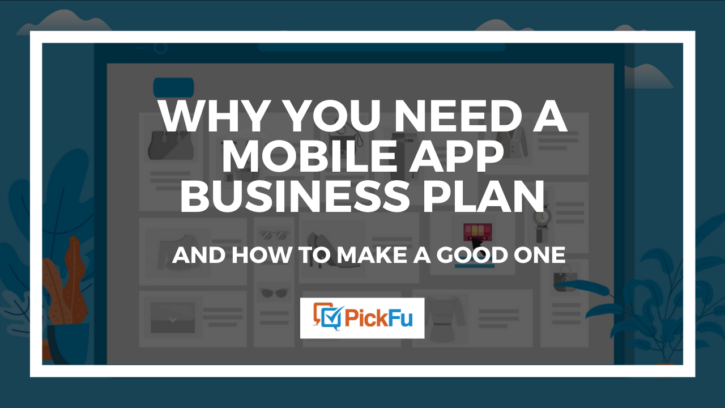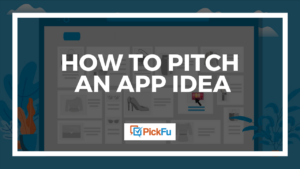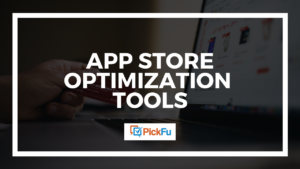It’s not cheap to build an app. One source says that building a simple functions app like a timer or a tip calculator costs upwards of $10,000. A more complicated app is much more expensive — think a quarter of a million dollars. So to build an app without sinking your finances, you need to create a mobile app business plan.
Before we dive into what that plan should look like, let’s figure out why your brand should develop an app in the first place.
Why does my business need an app?
A good app does two things:
- It gives customers a place to communicate with your brand, and vice versa. A good app will help you see the pitfalls and pluses of your overall brand.
- It does something valuable for the customer.
Take Craigslist, for example. For the longest time, Craigslist didn’t have its own app. This gave rise to all sorts of third-party Craigslist search and buy apps. The people who preferred buying or selling things through the actual site were forced to either do everything from a laptop or try to use Craigslist on a mobile web browser.
But in 2019, Craigslist finally published its own mobile app.
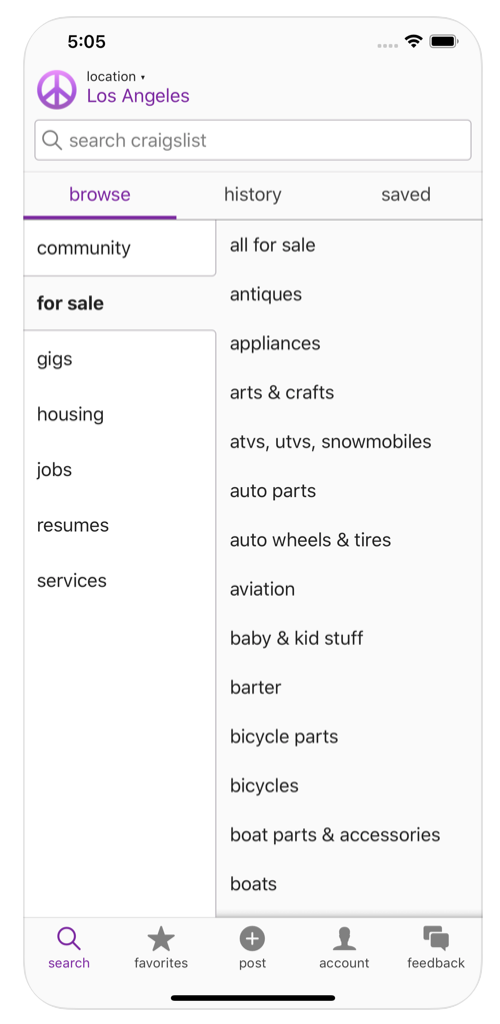
While third-party apps may have provided venues for feedback to the third-party brands (not Craigslist), the brand’s own app has a button just for feedback that goes straight to the Craigslist team for review.
This is how Craigslist is fulfilling that essential customer communication component of an excellent mobile app.
Craigslist also provides a valuable service for customers by giving them a way to buy and sell items on Craigslist from their mobile phones or tablets.
Here we come to the first reason your business needs an app.
Reason #1: Mobile apps are the ultimate form of convenience
You’ve probably noticed that we live in a hugely fast-paced world. Back when I was in college, iPhones were still a novelty. At the time, a friend of mine summed up the convenience of smartphones nicely: “It’s sweet to be able to Google a question right when it pops into your mind instead of having to wait until you get home to your laptop.”
Now it’s impossible to go anywhere without seeing faces bent over iPhones or Androids. We no longer have to be bored in grocery store lines — we can pay bills, answer emails, check social media, read, watch TV, edit videos, and much more.

This is all made possible by mobile apps (and a nice data plan).
Your brand needs an app because apps are essential to our current way of life. Instead of simply seeing if your brand has a nice website, potential customers will also check to see if you have a mobile app.
As a society, we’re way past wanting to wait until we get home to look up a movie review, find a well-reviewed restaurant, or buy a new e-book.
If you’ve just started out, keep track of where your website traffic comes from. Does a lot of it come from mobile web browsers? If so, that means people would appreciate the convenience and ease of an app — which can and should give them more options than your website does.
Reason #2: You run an e-commerce or brick-and-mortar store
If people buy your merchandise on a web browser, they’ll probably also buy it on a mobile app. And if your e-commerce brand targets a younger demographic (think millennials and Gen Z), you’ll definitely want to add an app to your business strategy.
But don’t discount
- 93% of Millennials
- 90% of Gen Xers
- 68% of Baby Boomers
- 40% of The Silent Generation (aka people into their ’90s)
All of these percentages of people use mobile apps since they’re the heart of smartphones. Make sure that you think about what extra value your app can add to your e-commerce brand.
For example, you can offer discounts and make use of push notifications. I allow push notifications from Target because like so many other Millennials, I love that store. When a banner pops up on my phone telling me that cardigans are 50% off, you can bet I’m jumping on the Target app and putting some sweaters in my shopping cart! I can also easily create Pick Up or Drive Up orders on the app, as well as use it in-store to help me find items.
This brings me to the next point: an app can be super helpful for brick-and-mortar stores. Being able to carry your phone into the store and find out exactly where to find a product saves me a lot of time.

For any brand, apps add a huge amount of value for customers. For e-commerce brands and physical stores, the value of a mobile app can be limitless.
Reason #3: Your competition has an app
If your competitor has an app, you need one too. Actually, your app needs to offer more communication and value than their app. So study similar brands’ apps and see what’s working — and what’s not.
Then make your app even better.
Now that you know why you need an app, it’s time to focus on what components your mobile app business plan should include.
The elements of a mobile app business plan
Step 1: Figure out how much your app will cost to build
Let’s break down why apps cost so much. Unless you have a high-tech, trained team with enough time to build an app, you’ll need to hire someone to build it for you.
- 500-700 hours to build a basic
utilities app, like a calculator - 700-1,000 hours to build a more complex but not super complicated app
- 1,200+ hours for a high-complexity app
Now that you have an estimate of the hours, take a look at hourly prices in a few regions:
- US and Canada: $200+ an hour
- UK: $175 per hour
- India: $50-75 per hour
That’s a wild variation of prices, and there are pros and cons to choosing local versus international app developers. (Here are 10 things to consider before hiring an app developer.)
To do some quick math, if you outsourced your app-building to an Indian app developer and your app took 500 hours to build, you’d pay $37,500. For a high-end app developed in the US, you could pay as much as $240,000.

Of course, the goal is to get all that money back at some time in the future, and then some. But it won’t happen right away.
Step 2 can help you get a firm grasp on your finances before you start building your app.
Step 2: Decide how you’ll make money from your app
Will you use in-app advertising for a free app? In-app purchases? Subscriptions? Give some free features and then charge for upgrades? A paid app?
After deciding which method you’ll use, run a test on PickFu to see what your potential target audience is willing to pay. This will give you better estimates for Step 3.
It would be terrible to assume customers would pay $30 for a Wolfram Alpha-type app, only to find out that most people won’t bite at that price but would willingly pay something closer to $15 to get quick help on their university math courses.
Step 3: Determine your CAC (customer acquisition cost), CLV (customer lifetime value), runway, and profit and loss statement
Neil Patel has an informative guide to CAC here. You can manually calculate your CAC using the formula mentioned in the article — business cost in a period of time divided by the number
Once you’ve got that number, figure out your customer lifetime value (CLV) using a calculator like this one at Fiksu. CLV gives you an estimate of how much money a certain number of customers can earn you every month.
Multiply that number by 12 and compare it to your CAC. If your CAC is higher than your CLV, you need to do some adjusting in your financial planning.
Now calculate your runway — i.e., how much time you can operate on whatever funding you currently have. Here’s the formula:
- Runway = (total funds) / (burn rate, or expenditure)
Knowing this number, along with the CLV and CAC, will give you a solid grasp on your finances before you start app development.

Finally, create a profit and loss statement, ideally for a years’ time. Find a template specifically for mobile apps here.
Once you’ve got your financials lined up, you’re ready to move on to find your customer base.
Step 4: Define your unique selling proposition (USP) and ideal customer
To put USP in the clearest terms possible, in this step you need to figure out why your app is better than all the other similar apps out there.
Here’s another place PickFu can help you. If you’re not sure whether your app idea is actually going to sell, create a PickFu poll and validate your idea.
You could also do this by getting your foot into the target audience community you’re looking to sell to — a world of people who love playing Candy Crush, for example, if your app is going to make Candy Crush look boring.
But that can take a lot of time. With PickFu, you get an audience of at least 50 respondents in as little as 15 minutes. And they all give you written feedback.
To use a PickFu poll for idea validation, simply ask, “Would you buy an app that helps you do [X] and [X]?”
Or ask for more specific feedback, like “Which of these ideas sounds more appealing to you?”
That’s what this PickFu user recently did:
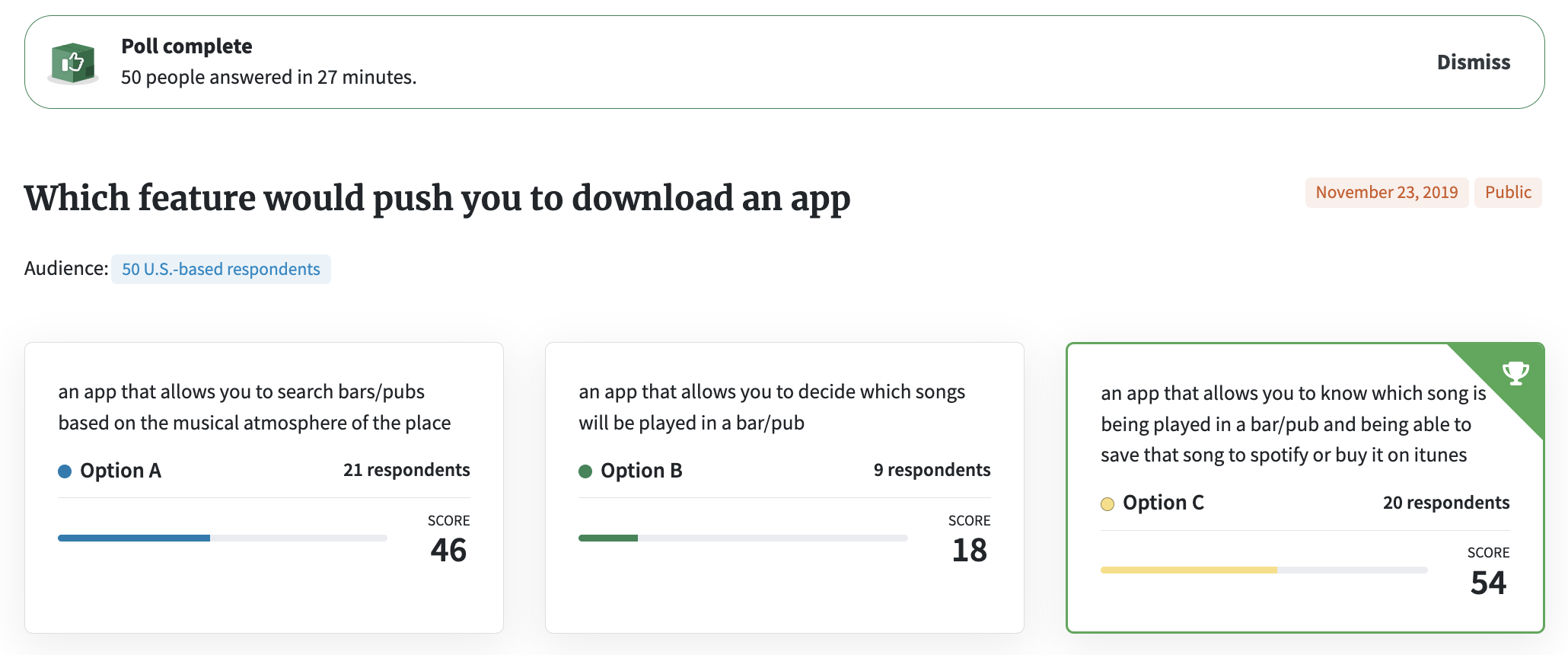
Note that the winner, Option C, fulfills a unique and distinct desire: it helps you quickly and easily, without having to do a Google search, identify the song you’re currently falling in boozy love with and save it for later — or buy it.
The app developer got dozens of comments detailing why poll respondents loved Option C, but this one says it all: “I have been there so many times. Hearing a song, not knowing the name, then remembering the tune and going crazy on Google trying to figure out the name of the song. This app would be so helpful. I want this so bad.”
That’s powerful, objective idea validation for you.
Because that’s the most important thing about PickFu: you’re asking an audience of people who don’t know you and who have no desire to make you feel good (like your mom does). By asking people you don’t know, you gain an honest perspective and learn the why behind their responses.
Idea validation won’t guarantee awesome sales. But it will let you know that people are interested in what you have to offer, freeing you to move into your app production with confidence.
Say your PickFu poll respondents are indifferent to the idea or even hate it. You may feel raw and bruised, but whew! You’ve just saved yourself a lot of work and money.
Don’t let yourself get too down,

Once you know that your idea will get attention, frame it in the most useful terms possible for your target audience. If you’re not sure who that audience is, create a user persona to help you identify who, exactly, your app will serve.
This will help you tremendously with Step #6.
Step 5: Analyze your market
The neat thing about PickFu is that once you know who your target market is, you can easily ask that audience all the questions you need to know as you create your mobile app business plan.
Here are some data points you can use for your app market research:
- Mobile gamers
- iOS/Android users
- App Store spenders
- Tablet users
- Audiobook listeners
- Podcast listeners
- E-book readers
Now that your idea is set, you can ask your target market which Google or Facebook ad they would click. Which email headline they’d open. You can even ask them questions about what type of marketing they’d respond to — would they pay attention to push notifications? Instagram ads? Incentivized user downloads? Mobile app wall ads?
Take their responses into stock when you detail your marketing efforts in this part of your business plan. Make sure to include App Store optimization in your plans, whatever other efforts you choose — it’s like SEO, but for the App Store and the Google Play Store.
As you work with your hired team to design the app, you can also ask your PickFu audience questions about:
- App screenshots
- Taglines
- App descriptions
- App icon design
- User interface design
You’ll get quick feedback during the entire app-building process. This will help you keep your app relevant and useful so that when it finally comes out, it’ll be primed for sales and satisfaction.
The proven perfect tool for your mobile app business plan
There are lots of useful mobile app tools out there, and PickFu stands out among the crowd. It’s
How do we know this? Because half of all the top-grossing iPhone apps use PickFu!

Here’s what developers have to say.



Now is the best time to get started on your mobile app business plan. With this guide and PickFu by your side, you’ll be on the road to mobile app success in no time.
Free download: PickFu/Utopia Analytics report on
toxic behavior in online gaming
